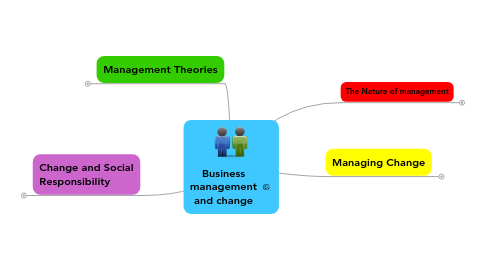
1. Management Theories
1.1. Behavioural
1.1.1. Management is viewed as motivating, leading and communicating and there is a democratic leadership style. There is a flatter management structure with a wider span of control. Employees are given more responsibility and are motivated to be more productive.
1.2. Classic-Scientific
1.2.1. Management is viewed as planning, organising and controlling. There is an autocratic leadership style. Through the division of labour, tasks are broken down into smaller operations. Employees are given little responsibility
1.3. Political
1.3.1. Acknowledges the role of power in the workplace e.g. Legimate Power (from position/status), Expert Power (knowledge), referent (natural charisma), reward power, coercive (use of threats / intimidation). It acknowldeges that coalitions (groups) exist and therefore managers should negotiate / bargain to balance the needs of all groups in the business
1.4. Advantages / disadvantges
1.4.1. Scientific - division of labour ensures that less training is needed, production is efficient and the finished products are uniform. Workers quickly become bored with repetitive tasks
1.4.2. Political - recognises that power exists in all workplaces. Sources of power are often difficult to recognise
2. Managing Change
2.1. Nature and sources of change in business
2.1.1. External influences
2.1.1.1. Changing nature of markets, economic – changes to the economic cycle, financial – access to global financial markets, geographic – Australia’s place in the Asia-Pacific region & demographic changes to Australia, social – family friendly programs and a more multicultural workplace, legal – deregulation and new legislation, political – privatisation, tax GST, free-trade policies, technological – allows business to reorganise their structure
2.1.2. Internal influences
2.1.2.1. Accelerating technology and e-commerce eg. Staff can work from home, internet shopping etc, new systems and procedures eg automated stock control, growth of the website, new business cultures – the importance of developing a culture of change – less formal organisations with a flatter management structure.
2.1.3. Structural responses to change
2.1.3.1. Outsourcing – less full time staff, more contract and part-time workers, flat structures – fewer middle management and more responsibility to frontline staff, growth of networked teams, strategic alliances and networks
2.2. Reasons for resistance to change
2.2.1. Staffing – deskilling – staff are no longer required to perform certain duties, managers may also have less responsibility, acquiring new skills – may find it hard work, loss of career prospects and promotional opportunities
2.2.2. Inertia of managers, owners – unenthusiastic response to change
2.2.3. Cultural incompatibility in mergers / takeovers eg. Failure of AOL and Time Warner
2.3. Managing change effectively
2.3.1. Identifying the need for change – managers need to understand why change is needed
2.3.2. Setting achievable goals – unrealistic goals will only make staff more resistant
2.3.3. Creating a culture of change (encouraging a teamwork approach using change agents – individuals who provide support for other staff undergoing change)
2.3.4. Change models – force field analysis. Lewin’s change / unfreeze, refreeze model
3. Change and Social Responsibility
3.1. ecological sustainability
3.1.1. growth in demand for environmentally friendly work practices and products
3.2. quality of working life
3.2.1. e.g. family friendly work programs, more flexible work arrangements, improvements to health and safety
3.3. technology
3.3.1. businesses must consider how technology e.g. e-mail will impact on workplace communication and interpersonal relationships among staff - technology may make people feel more isolated
3.4. globalisation / managing cultural diversity
3.4.1. The workplace is more diverse through globalisation - gender, race, ethnicity, religion, ability, sexual preference, age
3.5. e-commerce
3.5.1. some argue that business has the responsibility to minimise the disruption to workers through advancements in e-commerce
4. The Nature of management
4.1. The importance of effective management
4.1.1. The major factor influencing the success of a business
4.2. Management Roles
4.2.1. Interpersonal
4.2.1.1. Dealing with people inside and outside the business
4.2.2. Informational
4.2.2.1. the gathering and disseminating of informatiion within a business
4.2.3. Decisional
4.2.3.1. solving problems and making choices
4.3. Skills of management
4.3.1. People skills, strategic thinking, vision, flexibility and adaptability to change, self-managing, teamwork, complex problem solving and decision making, ethical and high personal standards
4.4. Responsibility to stakeholders, reconciling conflicts of interest
4.4.1. society expects businesses to accept responsibility and accountability to all stakeholders
